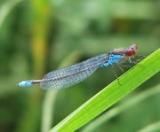
Small Red-eyed Damselfly
Encyclopedia
The Small Red-eyed Damselfly Erythromma viridulum is a member of the damselfly
family Coenagrionidae
. It is very similar to the Red-eyed Damselfly
.
Viewed from the side, the second and eighth segment
of the abdomen
of the male are mostly blue, which distinguishes it from the Red-eyed Damselfly where these are mostly black.
and Water Milfoil (Myriophyllum).
Eggs are laid while in tandem, into the stems and leaves of floating plants. The larvae live amongst pondweed and probably emerge after a year.
 Mating occurs either on floating plants or at the margins. When perched on floating plants, the male holds its abdomen slightly upcurved (the Red-eyed Damselfly holds it straight).
Mating occurs either on floating plants or at the margins. When perched on floating plants, the male holds its abdomen slightly upcurved (the Red-eyed Damselfly holds it straight).
considerably and become an established breeding resident. The first British record was in Essex
on 17 July 1999 and is documented in Dewick and Gerussi (2000). Breeding was finally proven in 2002.
Damselfly
Damselflies are insects in the order Odonata. Damselflies are similar to dragonflies, but the adults can be distinguished by the fact that the wings of most damselflies are held along, and parallel to, the body when at rest...
family Coenagrionidae
Coenagrionidae
The insect family Coenagrionidae is found in the order Odonata and the suborder Zygoptera. The Zygoptera are the damselflies, which although less known than the dragonflies, are no less common. There are more than 1100 species in this family, making it the largest damselfly family...
. It is very similar to the Red-eyed Damselfly
Red-eyed Damselfly
Red-eyed Damselfly Erythromma najas is a member of the damselfly family Coenagrionidae.-Appearance:The species is a small damselfly, long, predominantly black with iridescent blue markings. The male resembles blue-tailed damselflies but is distinguished by its large, spaced eyes that are a deep red...
.
Appearance
The species is a small damselfly, about 29 millimetres (1.1 in) long, predominantly black with iridescent blue markings. Its large, spaced eyes are a deep red. Like the Red-eyed Damselfly, both sexes lack pale spots behind the eyes and have pale brown pterostigmata. The male has a bronze-black top and blue sides. The sides of the female's thorax are yellow, green or blue. The rear edge of the pronotum is rounded.Viewed from the side, the second and eighth segment
Segmentation (biology)
Segmentation in biology refers to either a type of gastrointestinal motility or the division of some animal and plant body plans into a series of repetitive segments. This article will focus on the segmentation of animal body plans, specifically using the examples of the phyla Arthropoda,...
of the abdomen
Abdomen
In vertebrates such as mammals the abdomen constitutes the part of the body between the thorax and pelvis. The region enclosed by the abdomen is termed the abdominal cavity...
of the male are mostly blue, which distinguishes it from the Red-eyed Damselfly where these are mostly black.
Breeding
This damselfly breeds in ponds, lakes and ditches and, in continental Europe, sluggish rivers. It seems to be well able to tolerate brackish water. It seems to be associated with floating vegetation such as HornwortHornwort
Hornworts are a group of bryophytes, or non-vascular plants, comprising the division Anthocerotophyta. The common name refers to the elongated horn-like structure, which is the sporophyte. The flattened, green plant body of a hornwort is the gametophyte plant.Hornworts may be found worldwide,...
and Water Milfoil (Myriophyllum).
Eggs are laid while in tandem, into the stems and leaves of floating plants. The larvae live amongst pondweed and probably emerge after a year.
Behaviour

Colonisation of Britain
The populations of this species in northwest Europe increased in the latter part of the 20th century, and in 1999 the species was recorded in Britain for the first time. It has since increased its rangeRange (biology)
In biology, the range or distribution of a species is the geographical area within which that species can be found. Within that range, dispersion is variation in local density.The term is often qualified:...
considerably and become an established breeding resident. The first British record was in Essex
Essex
Essex is a ceremonial and non-metropolitan county in the East region of England, and one of the home counties. It is located to the northeast of Greater London. It borders with Cambridgeshire and Suffolk to the north, Hertfordshire to the west, Kent to the South and London to the south west...
on 17 July 1999 and is documented in Dewick and Gerussi (2000). Breeding was finally proven in 2002.

